Astronomy fanatica
-
For all astronomy lovers...

-
Astronomy
Astronomy, which etymologically means "law of the stars," (from Greek) is a science involving the observation and explanation of events occurring outside Earth and its atmosphere. It studies the origins, evolution, physical and chemical properties of objects that can be observed in the sky (and are outside the earth), as well as the processes involving them.
Lunar astronomy: the large crater is Daedalus, photographed by the crew of Apollo 11 as they circled the Moon in 1969. Located near the center of the far side of Earth's Moon, its diameter is about 93 kilometers (58 miles).
Astronomy is one of the few sciences where amateurs can still play an active role, especially in the discovery and monitoring of transient phenomena. Astronomy is not to be confused with astrology, which assumes that people's destiny and human affairs in general are correlated to the apparent positions of astronomical objects in the sky -- although the two fields share a common origin, they are quite different; astronomers embrace the scientific method, while astrologers do not.
Issue #1 -
Astronomy Picture of the Day
Discover the cosmos! Each day a different image or photograph of our fascinating universe is featured, along with a brief explanation written by a professional astronomer.
2005 February 20
Oklo: Ancient African Nuclear Reactors
Explanation: The remnants of nuclear reactors nearly two billion years old were found in the 1970s in Africa. These reactors are thought to have occurred naturally. No natural reactors exist today, as the relative density of fissile uranium has now decayed below that needed for a sustainable reaction. Pictured above is Fossil Reactor 15, located in Oklo, Gabon. Uranium oxide remains are visible as the yellowish rock. Oklo by-products are being used today to probe the stability of the fundamental constants over cosmological time-scales and to develop more effective means for disposing of human-manufactured nuclear waste.
Credit & Copyright: Robert D. Loss, CEMS -
Here's a cool place if you like astronomy: http://www.eso.org/
-
Astronomy Picture of the Day
2005 February 21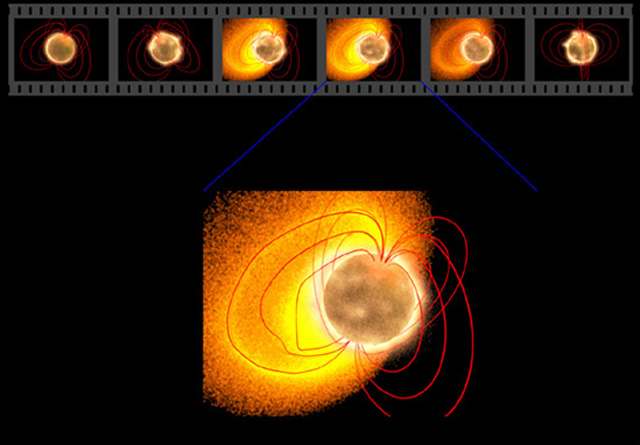
Galactic Magnetar Throws Giant Flare
Explanation: Was the brightest Galactic blast yet recorded a key to connecting two types of celestial explosions? Last December, a dense sheet of gamma rays only a few times wider than the Earth plowed through our Solar System, saturating satellites and noticeably reflecting off the Moon. A magnetar near our Galactic Center, the source of Soft Gamma Repeater (SGR) 1806-20, had unleashed its largest flare on record. The brightness and briefness of the tremendous explosion's initial peak made it look quite similar to another type of tremendous explosion if viewed from further away -- a short duration gamma-ray burst (GRB). Short duration GRBs are thought by many to be fundamentally different than their long duration GRB cousins that are likely related to distant supernovas. Illustrated above is a series of drawings depicting an outgoing explosion during the initial SGR spike. A fast moving wave of radiation is pictured shooting away from a central magnetar. The possible link between SGRs and GRBs should become better understood as more and similar events are detected by the Earth-orbiting Swift satellite.
Illustration Credit & Copyright: Robert Mallozzi (UAH, MSFC) -
Divisions of astronomy
In ancient Greece and other early civilizations, astronomy consisted largely of astrometry, measuring positions of stars and planets in the sky. Later, the work of Kepler and Newton paved the way for celestial mechanics, mathematically predicting the motions of celestial bodies interacting under gravity, and solar system objects in particular. Much of the effort in these two areas, once done largely by hand, is highly automated nowadays, to the extent that they are rarely considered as independent disciplines anymore. Motions and positions of objects are now more easily determined, and modern astronomy concerns itself much more with trying to observe and understand the actual physical nature of celestial objects—what makes them "tick".
Ever since the twentieth century the field of professional astronomy has tended to split into observational astronomy and theoretical astrophysics. Although most astronomers incorporate elements of both into their research, because of the different skills involved, most professional astronomers tend to specialize in one or the other.
Observational astronomy is concerned mostly with acquiring data, which involves building and maintaining instruments and processing the resulting information; this branch is at times referred to as "astrometry" or simply as "astronomy".
Theoretical astrophysics is concerned mainly with figuring out the observational implications of different models, and involves working with computer or analytic models.
The fields of study are also categorized in another two ways: by "subject", usually according to the region of space (e.g. Galactic astronomy) or "problems addressed" (such as star formation or cosmology); or by the way used for obtaining information.
Issue #2 -
Astronomy Picture of the Day
2005 February 22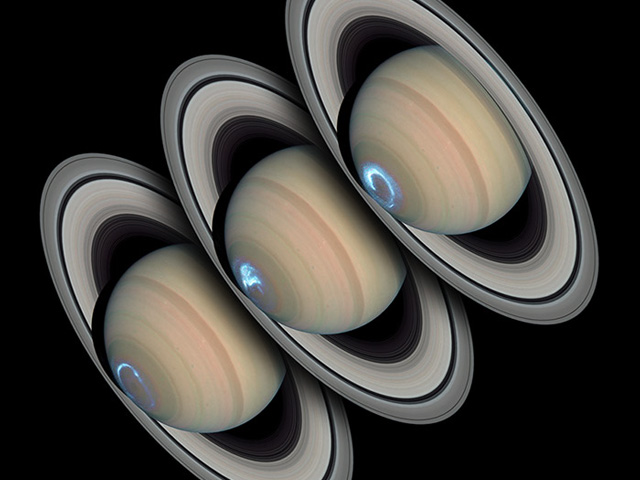
Persistent Saturnian Auroras
Explanation: Are Saturn's auroras like Earth's? To help answer this question, the Hubble Space Telescope and the Cassini spacecraft monitored Saturn's South Pole simultaneously as Cassini closed in on the gas giant in January 2004. Hubble snapped images in ultraviolet light, while Cassini recorded radio emissions and monitored the solar wind. Like on Earth, Saturn's auroras make total or partial rings around magnetic poles. Unlike on Earth, however, Saturn's auroras persist for days, as opposed to only minutes on Earth. Although surely created by charged particles entering the atmosphere, Saturn's auroras also appear to be more closely modulated by the solar wind than either Earth's or Jupiter's auroras. The above sequence shows three Hubble images of Saturn each taken two days apart.
Credit: J. Clarke (Boston U.) & Z. Levay (STScI), ESA, NASA -
Astronomy Picture of the Day
2005 February 23
Voyage of an Antarctic Iceberg
Explanation: What if part of New York broke off and slammed into New Jersey? Both being anchored land masses, that is unlikely to happen, but an event of that size scale did occur off the Antarctic coast over the last three months. Long Island, New York sized B-15A iceberg floated across 100 kilometers of the Ross Sea and struck a submarine shoal just before an expected impact with the massive Drygalski Ice Tongue, visible on the bottom right of the last image. As it is summer in Earth's Southern Hemisphere, the relatively warm weather was expected to melt and clear much of surrounding ice, but now B-15A blocks much of this ice from floating out to sea. This created a problem not only for ships servicing McMurdo Station but also for penguins expecting to swim. The greater Ross Ice Shelf, from which B-15A calved, has shed several large icebergs over the past few years.
Credit: MODIS, Terra, NASA -
Divisions of astronomy - Cont'd
By subject or problem addressed
Astrometry: the study of the position of objects in the sky and their changes of position. Defines the system of coordinates used and the kinematics of objects in our galaxy.
Astrophysics: the study of physics of the universe, including the physical properties (luminosity, density, temperature, chemical composition) of astronomical objects.
Cosmology: the study of the origin of the universe and its evolution. The study of cosmology is theoretical astrophysics at its largest scale.
Galaxy formation and evolution: the study of the formation of the galaxies, and their evolution.
Galactic astronomy: the study of the structure and components of our galaxy and of other galaxies.
Extragalactic astronomy: the study of objects (mainly galaxies) outside our galaxy.
Stellar astronomy: the study of the stars.
Stellar evolution: the study of the evolution of stars from their formation to their end as a stellar remnant.
Star formation: the study of the condition and processes that led to the formation of stars in the interior of gas clouds, and the process of formation itself.
Planetary Sciences: the study of the planets of the solar system.
Astrobiology: the study of the advent and evolution of biological systems in the universe.
Also, there are other disciplines that may be considered part of astronomy:
- Archaeoastronomy
- Astrochemistry
Planetary astronomy, or Planetary Sciences: a dust devil on Mars. Photographed by Mars Global Surveyor, the long dark streak is formed by a moving swirling column of Martian atmosphere (with similarities to a terrestrial tornado). The dust devil itself (the black spot) is climbing the crater wall. The streaks on the right are sand dunes on the crater floor.
Issue #3 -
Astronomy Picture of the Day
2005 February 24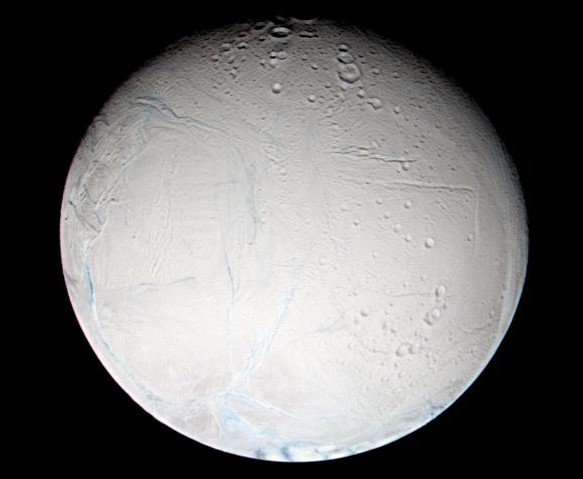
Ski Enceladus
Explanation: Small, icy, inner moon of Saturn, Enceladus is only about 500 kilometers in diameter. But the distant world does reflect over 90 percent of the sunlight it receives, giving its surface about the same reflectivity as fresh snow. Seen here in a sharp view from the Cassini spacecraft's recent flyby, Enceladus shows a variety of surface features and very few impact craters - indicating that it has been an active world even though this tiny moon should have completely cooled off long ago. In fact, the resurfaced appearance of Enceladus could be the result of liquid water geysers or water volcanos. Since Enceladus orbits within the outer E ring of Saturn, the moon's surface may be kept snow-bright as it is continuously bombarded with icy ring particles. Eruptions on Enceladus itself would in turn supply material to the E ring. Interplanetary ski bums take note: tiny Enceladus has only about 1/100th the surface gravity of planet Earth and a surface temperature of -200 degrees C (-330 degrees F).
Credit: Cassini Imaging Team, SSI, JPL, ESA, NASA -
Divisions of astronomy - Cont'd
Ways of obtaining information
In astronomy, information is mainly received from the detection and analysis of electromagnetic radiation, photons, but information is also carried by cosmic rays, neutrinos, meteors, and, in the near future, gravitational waves.
A traditional division of astronomy is given by the region of the electromagnetic spectrum observed:
Optical astronomy is the part of astronomy that uses specialized equipment to detect and analyze light in and slightly around the wavelengths that can be detected with the eyes (about 400 - 800 nm). The most common tool is the telescope, with electronic imagers and spectrographs.
Infrared astronomy deals with the detection and analysis of infrared radiation (wavelengths longer than red light). The most common tool is the telescope but with the instrument optimized for infrared. Space telescopes are also used to eliminate noise (electromagnetic interference) from the atmosphere.
Radio astronomy detects radiation of millimetre to dekametre wavelength. The receivers are similar to those used in radio broadcast transmission but much more sensitive. See also Radio telescopes.
High-energy astronomy
Extragalactic astronomy: gravitational lensing. This image shows several blue, loop-shaped objects that are multiple images of the same galaxy, duplicated by the gravitational lens effect of the cluster of yellow galaxies near the photograph's center. The lens is produced by the cluster's gravitational field that bends light to magnify and distort the image of a more distant object.
Optical and radio astronomy can be performed with ground-based observatories, because the atmosphere is transparent at the wavelengths being detected. Infrared light is heavily absorbed by water vapor, so infrared observatories have to be located in high, dry places or in space.
The atmosphere is opaque at the wavelengths used by X-ray astronomy, gamma-ray astronomy, UV astronomy and (except for a few wavelength "windows") Far infrared astronomy, so observations can be carried out mostly from balloons or space observatories. Powerful gamma rays can, however be detected by the large air showers they produce, and the study of cosmic rays can also be regarded as a branch of astronomy.
Issue #4 -
-
Astronomy Picture of the Day
2005 February 25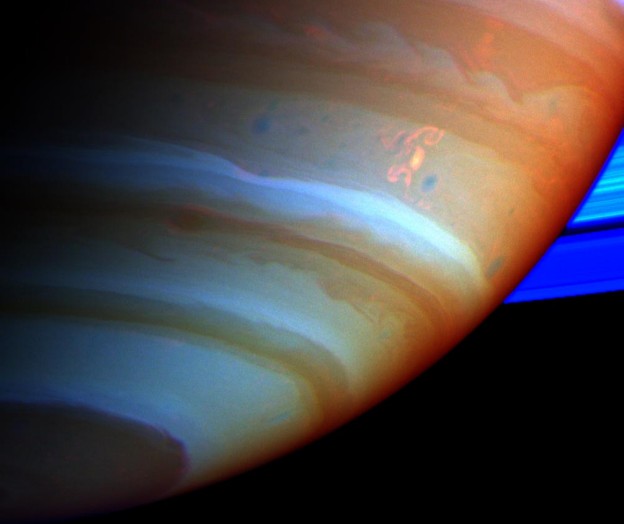
Saturn's Dragon Storm
Explanation: Dubbed the "Dragon Storm", convoluted, swirling cloud features are tinted orange in this false-color, near-infrared image of Saturn's southern hemisphere. In one of a series of discoveries announced by Cassini researchers, the Dragon Storm was found to be responsible for mysterious bursts of radio static monitored by Cassini instruments during the last year as the spacecraft orbited the ringed planet. The storm is now thought to be a giant Saturnian thunderstorm, like storms on Earth, with radio noise produced in high-voltage lightning discharges. The Cassini observations are also consistent with the Dragon Storm being a long-lived storm, deep within the gas giant's atmosphere, that periodically flares-up to produce large, visible storm regions.
Image Credit: Cassini Imaging Team, SSI, JPL, ESA, NASA -
Short history of astronomy
In early times, astronomy involved only the observation and predictions of the motions of the naked-eye objects. The Rigveda refers to the 27 constellations associated with the motions of the sun and also the 12 zodiacal divisions of the sky. The ancient Greeks made important contributions to astronomy, among them the definition of the magnitude system. The Bible contains a number of statements on the position of the earth in the universe and the nature of the stars and planets, most of which are poetic rather than literal. In 500 AD, Aryabhata presented a mathematical system that took the earth to spin on its axis and considered the motions of the planets with respect to the sun.
Observational astronomy was mostly stagnant in medieval Europe, but flourished in the Arab world. The late 9th century Islamic astronomer al-Farghani wrote extensively on the motion of celestial bodies. His work was translated into Latin in the 12th century. In the late 10th century, a huge observatory was built near Tehran, Persia (now Iran), by the astronomer al-Khujandi, who observed a series of meridian transits of the Sun, which allowed him to calculate the obliquity of the ecliptic. Also in Persia, Omar Khayyam performed a reformation of the calendar that was more accurate than the Julian and came close to the Gregorian.
During the Renaissance, Copernicus proposed a heliocentric model of the Solar System. His work was defended, expanded upon, and corrected by Galileo Galilei and Johannes Kepler. Galileo added the innovation of using telescopes to enhance his observations. Kepler was the first to devise a system that described correctly the details of the motion of the planets with the Sun at the center. However, Kepler did not succeed in formulating a theory behind the laws he wrote down. It was left to Newton's invention of celestial dynamics and his law of gravitation to finally explain the motions of the planets. Newton also developed the reflecting telescope.
Stars were found to be faraway objects. With the advent of spectroscopy it was proved that they were similar to our own sun, but with a wide range of temperatures, masses, and sizes. The existence of our galaxy, the Milky Way, as a separate group of stars was only proven in the 20th century, along with the existence of "external" galaxies, and soon after, the expansion of the universe, seen in the recession of most galaxies from us. Cosmology made huge advances during the 20th century, with the model of the Big Bang heavily supported by the evidence provided by astronomy and physics, such as the cosmic microwave background radiation, Hubble's Law, and cosmological abundances of elements.
Issue #5 -
Astronomy Picture of the Day
2005 February 26
Frizion Illume
Explanation: Scientific images of cosmic dust clouds or even frozen water can be esthetic too. In fact, this picture of thin layers of forming ice crystals uses a scientific understanding of light's wave properties solely for artistic purposes. Titled "Illume", the picture was created by astrophysicist Peter Wasilewski. To make the picture, the crystals were illuminated by light shining through a polarizing filter -- a filter that restricts the otherwise randomly oriented light waves to vibrate in only one direction. While passing through the ice, different colors of the polarized light are then refracted and reflected along slightly different paths by the delicate crystalline layers. Viewing the scene with a second polarizing filter brings out the wondrous display of structure and color. Painting with "light, the laws of physics, and an attitude" Wasilewski has created a series of these evocative ice images that he refers to as Frozen Vision or Frizion.
Credit & Copyright: Peter Wasilewski (Goddard Space Flight Center) -
What's the latest in discovery??? I'm waiting for the time we can over to other stars, that would be cool!!!!
Whatz the progress with the Mars travel issue??? Are they gonna send people there yet??? I though they mention something about a space cruise, where people can travel on something like a spaceship airline??? -
not in the near futureOriginally posted by AntiAnti:What's the latest in discovery??? I'm waiting for the time we can over to other stars, that would be cool!!!!
Whatz the progress with the Mars travel issue??? Are they gonna send people there yet??? I though they mention something about a space cruise, where people can travel on something like a spaceship airline???
the last is only reserved for the super rich
-
Astrometry
Astrometry is a part of astronomy and deals with the positions of stars and other celestial bodies, their distances and movements. Part of astrometry involves creating the cosmic distance ladder.
It is one of the oldest subfields of the science, the successor to the more qualitative study of positional astronomy. Astrometry dates back at least to Hipparchus, who compiled the first catalogue of stars visible to him and in doing so invented the brightness scale basically still in use today. Modern astrometry was founded by Friedrich Bessel with his Fundamenta astronomiae, which gave the mean position of 3222 stars observed between 1750 and 1762 by James Bradley.
Apart from the fundamental function of providing astronomers with a reference frame to report their observations in, astrometry is also fundamental for fields like celestial mechanics, stellar dynamics and galactic astronomy. In observational astronomy, astrometric techniques help identify stellar objects by their unique motions. It is also instrumental for keeping time, in that UTC is basically the atomic time synchronized to Earth's rotation by means of exact observations.
There have been several important advances in astrometry.
- Sundials were effective at measuring time.
- Astrolabes were invented for measuring celestial angles.
- Astrometric applications led to the development of spherical geometry.
- Careful measurement of planetary motions by Tycho Brahe proved the Copernican principle, that Earth revolves about the Sun.
- The sextant dramatically improved measurement of celestial angles.
- The development of cheap charge coupled devices, software, and telescopes allowed for large-scale amateur astrometric observation of minor planets.
Another was the use of Cepheid variable stars to measure the distance to nebulae, which led to the discovery of other galaxies by Edwin Hubble. Hubble used triangulation on nearby Cepheids, and correlated the Cepheid's period to their absolute brightness. Then by measuring the period and brightness of Cepheids in nebulae, he established their distance by their brightness.
Hubble used Cepheids to discover and calibrate distance with the red shift shown by distant galaxies.
From 1989 to 1993, the European Space Agency's Hipparcos satellite performed astrometric measurements resulting in a catalogue of positions accurate to 20-30 milliarcsec for over a million stars.
Astronomers use astrometric techniques for the tracking of near-Earth objects. It has been also been used to detect extrasolar planets by measuring the doppler shift they cause in their parent star's spectrum. NASA's planned Space Interferometry Mission will utilize astrometric techniques to detect gas giants around other stars, and perhaps even terrestrial planets nearby.
Astrometric measurements are used by astrophysicists to constrain certain models in celestial mechanics. By measuring the velocities of pulsars, it is possible to put a limit on the asymmetry of supernova explosions. Also, astrometric results are used to determin the distribution of dark matter in the galaxy.
Astrometrics is the science of stellar measurements and motion. Astrometrics was used, during the 1990s, to detect extrasolar gas giants orbiting various solar systems. This was done by observing the "stellar wobble" of a star and calculating what kinds of gravitational forces would cause such motion; it was then determined that planetary forces must be affecting the stars in question.
Issue #6 -
Astronomy Picture of the Day
2005 February 27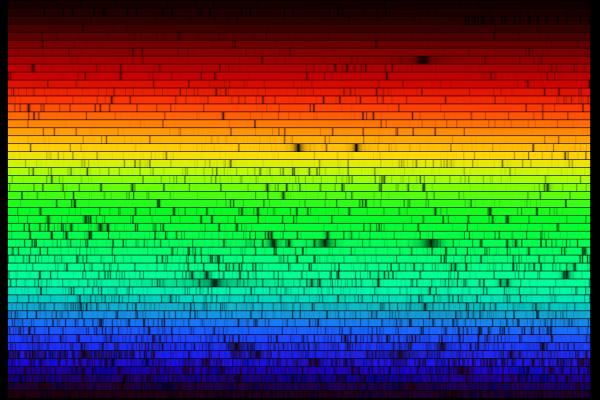
The Solar Spectrum
Explanation: It is still not known why the Sun's light is missing some colors. Shown above are all the visible colors of the Sun, produced by passing the Sun's light through a prism-like device. The above spectrum was created at the McMath-Pierce Solar Observatory and shows, first off, that although our yellow-appearing Sun emits light of nearly every color, it does indeed appear brightest in yellow-green light. The dark patches in the above spectrum arise from gas at or above the Sun's surface absorbing sunlight emitted below. Since different types of gas absorb different colors of light, it is possible to determine what gasses compose the Sun. Helium, for example, was first discovered in 1870 on a solar spectrum and only later found here on Earth. Today, the majority of spectral absorption lines have been identified - but not all.
Credit & Copyright: Nigel Sharp (NSF), FTS, NSO, KPNO, AURA, NSF -
Astrophysics
Astrophysics is the branch of astronomy that deals with the physics of the universe, including the physical properties (luminosity, density, temperature and chemical composition) of astronomical objects such as stars, galaxies, and the interstellar medium, as well as their interactions. The study of cosmology is theoretical astrophysics at its largest scale; conversely, since the energies involved in cosmology, especially the Big Bang, are the largest known, the observations of the cosmos also serve as the laboratory for physics at its smallest scales as well.
Spiral Galaxy ESO 269-57
In practice, virtually all modern astronomical research involves a substantial amount of physics. The name of a school's doctoral program ("Astrophysics" or "Astronomy") in many places like the United States often has to do more with the department's history than with the contents of the programs.
History
Although astronomy is as old as recorded history, it was long separated from the study of physics. In the Aristotelian worldview, the celestial pertained to perfection—bodies in the sky being perfect spheres moving in perfectly circular orbits—while the earthly pertained to imperfection; these two realms were seen as unrelated.
For centuries, the apparently common-sense view that the Sun and other planets went round the Earth went unquestioned, until Nicolaus Copernicus suggested in the 16th century that the Earth and all the other planets in the Solar System orbited the Sun. Galileo Galilei made quantitative measurements central to physics, but in astronomy his observation didn't have astrophysical significance.
The availability of accurate observational data led to research into theoretical explanations for the observed behavior. At first, only ad-hoc rules were discovered, such as Kepler's laws of planetary motion, discovered at the start of the 17th century. Later that century, Isaac Newton, bridged the gap between Kepler's laws and Galileo's dynamics, discovering that the same laws that rule the dynamics of objects on earth rules the motion of planets and the moon. Celestial mechanics, the application of Newtonian gravity and Newton's laws to explain Kepler's laws of planetary motion, was the first unification of astronomy and physics.
After Isaac Newton published his Principia, maritime navigation was transformed. Starting around 1670, the entire world was measured using essentially modern latitude instruments and the best available clocks. The needs of navigation provided a drive for progressively more accurate astronomical observations and instruments, providing a background for ever more available data for scientists.
At the end of the 19th century it was discovered that, when decomposing the light from the Sun, a multitude of spectral lines were observed (regions where there was less or no light). Experiments with hot gases showed that the same lines could be observed in the spectra of gases, specific lines corresponding to unique chemical elements. In this way it was proved that the chemical elements found in the Sun (chiefly hydrogen) were also found on Earth. Indeed, the element helium was first discovered in the spectrum of the sun and only later on earth, hence its name. During the 20th century, spectrometry (the study of these spectral lines) advanced, particularly as a result of the advent of quantum physics that was necessary to understand the astronomical and experimental observations.
Observational astrophysics
Most astrophysical processes cannot be reproduced in laboratories on Earth. However, there is a huge variety of astronomical objects visible all over the electromagnetic spectrum. The study of these objects through passive collection of data is the goal of observational astrophysics.
The equipment and techniques required to study an astrophysical phenomenon can vary widely. Many astrophysical phenomena that are of current interest can only be studied by using very advanced technology and were simply not known until very recently.
The majority of astrophysical observations are made using the electromagnetic spectrum.
- Radio astronomy studies radiation with a wavelength greater than a few millimeters. Radio waves are usually emitted by cold objects, including interstellar gas and dust clouds. The cosmic microwave background radiation is the redshifted light from the Big Bang. Pulsars were first detected at microwave frequencies. The study of these waves requires very large radio telescopes.
- Infrared astronomy studies radiation with a wavelength that is too long to be visible but shorter than radio waves. Infrared observations are usually made with telescopes similar to the usual optical telescopes. Objects colder than stars (such as planets) are normally studied at infrared frequencies.
- Optical astronomy is the oldest kind of astronomy. Telescopes and spectroscopes are the most common instruments used. The Earth's atmosphere interferes somewhat with optical observations, so adaptive optics and space telescopes are used to obtain the highest possible image quality. In this range, stars are highly visible, and many chemical spectra can be observed to study the chemical composition of stars, galaxies and nebulae.
- Ultraviolet, X-ray and gamma ray astronomy study very energetic processes such as binary pulsars, black holes, magnetars, and many others. These kinds of radiation do not penetrate the Earth's atmosphere well, so they are studied with space-based telescopes such as RXTE, the Chandra X-ray Observatory and the Compton Gamma Ray Observatory.
Other than electromagnetic radiation, few things may be observed from the Earth that originate from great distances. A few gravitational wave observatories have been constructed, but gravitational waves are extremely difficult to detect. Neutrino observatories have also been built, primarily to study our Sun. Cosmic rays consisting of very high energy particles can be observed hitting the Earth's atmosphere.
Observations can also vary in their time scale. Most optical observations take minutes to hours, so phenomena that change faster than this cannot readily be observed. However, historical data on some objects is available spanning centuries or millennia. On the other hand, radio observations may look at events on a millisecond timescale (millisecond pulsars) or combine years of data (pulsar deceleration studies). The information obtained from these different timescales is very different.
The study of our own Sun has a special place in observational astrophysics. Due to the tremendous distance of all other stars, the Sun can be observed in a kind of detail unparalleled by any other star. Our understanding of our own sun serves as a guide to our understanding of other stars.
The topic of how stars change, or stellar evolution, is often modelled by placing the varieties of star types in their respective positions on the Hertzsprung-Russell diagram, which can be viewed as representing the state of a stellar object, from birth to destruction. The material composition of the astronomical objects can often be examined using:
- spectroscopy
- radio astronomy
- astronomical observatories
Theoretical astrophysics
Theoretical astrophysicists create and evaluate models to reproduce and predict observations. They use a wide variety of tools which include analytical models (for example, polytropes to approximate the behaviors of a star) and computational numerical simulations.
Dark matter and dark energy are currently topics in astrophysics, as their discovery and controversy originated during the study of the galaxies.
Issue #7 -
Astronomy Picture of the Day
2005 February 28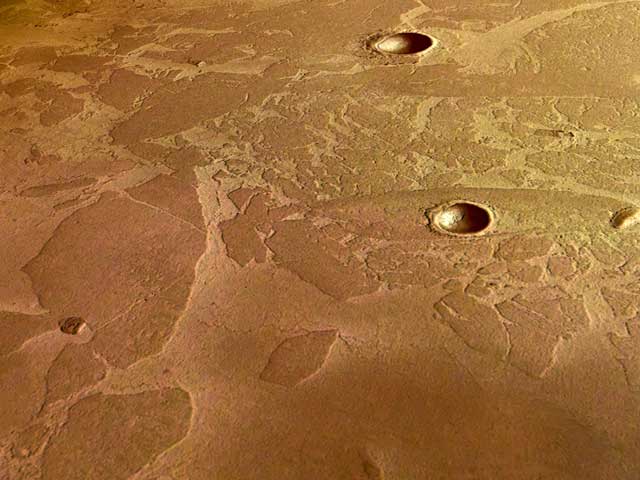
Unusual Plates on Mars
Explanation: What are those unusual plates on Mars? A leading current interpretation holds that they are blocks of ice floating on a recently frozen sea covered by dust. The unusual plates were photographed recently by the European Space Agency's Mars Express spacecraft currently orbiting Mars. Oddly, the region lies near the Martian equator and not near either of Mars' frozen polar caps. Without being covered by dust, any water or ice near away from the poles would quickly evaporate right into the atmosphere. Evidence that the above-imaged plates really are dust-covered water-ice includes a similarity in appearance to ice blocks off Earth's Antarctica, nearby surface fractures from which underground water could have flowed, and the shallow depth of the craters indicating that something is filling them in. If correct, the low abundance of craters indicates that water may have flowed on Mars as recently as five million years ago.
Credit: G. Neukum (FU Berlin) et al., Mars Express, DLR, ESA -
Cosmology
Cosmology is the study of the large-scale structure and history of the universe. In particular, it deals with subjects regarding its origin and evolution. It is studied by astronomy, philosophy, and religion.
Physical cosmology
- The Big Bang
-- The Friedmann-Lemaître-Robertson-Walker metric
-- The shape of the universe in big bang theory
- Cosmological principle
- Hubble Law
-- Comoving distance
- Cosmic microwave background (CMB)
-- Cosmic variance
- Big bang nucleosynthesis
- Galaxy Formation and Evolution
- Large Scale Structure of the Cosmos - few 100 Mpc - a few percent of the horizon
- Dark matter
- Dark energy
- Cosmic inflation
- Topological defects
- The Ultimate fate of the Universe
Due to the extreme conditions believed to be present during the first minutes of the universe's history, cosmologists often co-operate with scientists from areas such as particle physics.
Other cosmologies
Other cosmologies include:
- Philosophical cosmology
-- Presocratic philosophers
-- Anthropic principle
- Religious cosmology
Issue #8 -
Astronomy Picture of the Day
2005 March 1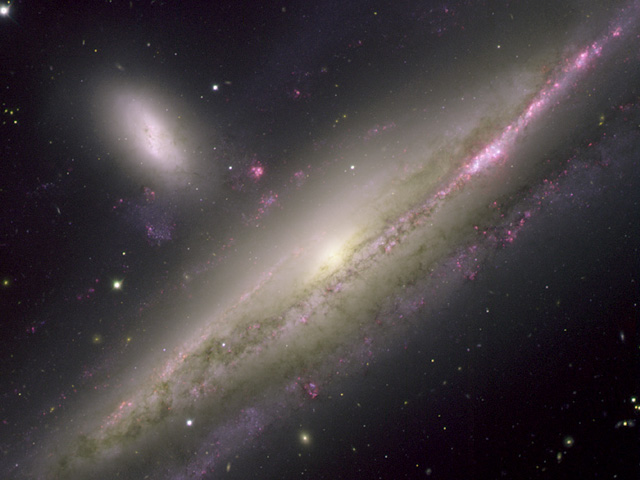
NGC 1531/2: Interacting Galaxies
Explanation: This dramatic image of an interacting pair of galaxies was made using 8-meter Gemini South telescope at Cerro Pachon, Chile. NGC 1531 is the background galaxy with a bright core just above center and NGC 1532 is the foreground spiral galaxy laced with dust lanes. The pair is about 55 million light-years away in the southern constellation Eridanus. These galaxies lie close enough together so that each feels the influence of the other's gravity. The gravitational tug-of-war was triggered star formation in the foreground spiral as evidenced by the young, bright blue star clusters along the upper edge of the front spiral arm. Though the spiral galaxy in this pair is viewed nearly edge-on, astronomers believe the system is similar to the face-on spiral and companion known as M51, the Whirlpool Galaxy.
Credit & Copyright: T. Rector (U. Alaska Anchorage), Gemini Obs., AURA, NSF -
Galaxy formation and evolution
In astrophysics, the questions of galaxy formation and evolution are:
- How, from a homogeneous universe, did we obtain the very inhomogeneous one we live in?
- How did galaxies form?
- How do galaxies change over time?
The formation of galaxies is still one of the most active research areas in astrophysics; and, to some extent, this is also true for galaxy evolution. Some ideas, however, are now widely accepted.
A spectacular head-on collision between two galaxies is seen in this NASA Hubble Space Telescope true-color image of the Cartwheel Galaxy.
After the Big Bang, the universe had a period when it was remarkably homogeneous, as can be observed in the Cosmic Microwave Background, the fluctuations of which are less than one part in one hundred thousand.
The most accepted view is that all the structure we observe today was formed as a consequence of the growing of primordial fluctuations by gravitational instability. Recent data strongly suggests that the first galaxies formed as early as 600 million years after the Big Bang, much earlier than astronomers had previously believed. That leaves hardly enough time for the tiny primordial instabilities to grow sufficiently forming protogalaxies into galaxies.
A great deal of the research in this area is focused on components of our own Milky Way, since it is the easiest galaxy to observe. The observations which must be explained in, or at least not at odds with, a theory of galactic evolution, include:
- The stellar disk is quite thin, dense, and rotates.
- The stellar halo is very large, sparse, and does not rotate (or has perhaps even a slight retrograde rotation), with no apparent substructure.
- Halo stars are typically much older and have much lower metallicities than disk stars (there is a correlation, but there is no absolute connection between these data).
- Some astronomers have identified an intermediate population of stars, variously called the "metal weak thick disk", the "intermediate population II", et al. If these are indeed a distinct population, they would be described as metal-poor (but not as poor as the halo stars), old (but not as old as the halo stars), and orbiting very near the disk, in a sort of "puffed-up", thicker disk shape.
- Globular clusters are typically old and metal-poor as well, but there are a few which are not nearly as metal-poor as most, and/or have some younger stars. Some stars in globular clusters appear to be as old as the universe itself (by entirely different measurement and analysis methods)!
- In each globular cluster, all the stars were born at virtually the same time (except for a few globulars that show multiple epochs of star formation).
- Globular clusters with smaller orbits (closer to the galactic center) have orbits which are somewhat flatter (less inclined to the disk), and less eccentric (more circular), while those further out have orbits in all inclinations, and tend to be more eccentric.
- High Velocity Clouds, clouds of neutral hydrogen are "raining" down on the galaxy, and presumably have been from the beginning (these would be the necessary source of a gas disk from which the disk stars formed).
- and many more interesting data.
Issue #9 -
Astronomy Picture of the Day
2005 March 2
The Powerful Sumatra-Andaman Islands Earthquake
Explanation: December's 9.0 earthquake has likely shortened Earth's day by about three microseconds and may also have tweaked Earth's rotational wobble. The megathrust earthquake occurred as the Indian tectonic plate slid further beneath the Burma tectonic plate. The earthquake was the fourth most powerful since the year 1900 and triggered tsunamis that tragically killed over 250,000 people in nearby coastal regions. In the above map, the yellow star indicates the location of the main earthquake, while circles show the locations of large aftershocks. The Sumatra-Andaman Islands earthquake's effect on the Earth's rotation was sudden but much smaller than the accumulated effects of other surface events such as an El Nino.
Credit: USGS